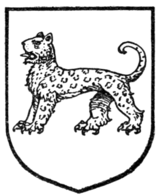When it became desirable to introduce the real tiger into British armory as typical of India and our Eastern Empire, something of course was necessary to distinguish it from the tyger which had previously usurped the name in armory, and for this reason the natural tiger is always heraldically known as the Bengal tiger. This armorial variety appears towards the end of the eighteenth century in this country, though in foreign heraldry it appears to have been recognised somewhat earlier. There are, however, but few cases in which the Bengal tiger has appeared in armory, and in the majority of these cases as a supporter, as in the supporters of Outram, which are two tigers rampant guardant gorged with wreaths of laurel and crowned with Eastern crowns all proper. Another instance of the tiger as a supporter will be found in the arms of Bombay. An instance in which it appears as a charge upon a shield will be found in the arms granted to the University of Madras.
 Fig. 326.—Leopard passant. |
 Fig. 327.—Leopard passant guardant. |
 Fig. 328.—Leopard rampant. |
Another coat is that granted in 1874 to Augustus Beaty Bradbury of Edinburgh, which was: "Argent, on a mount in base vert, a Bengal tiger passant proper, on a chief of the second two other tigers dormant also proper." A tigress is said to be occasionally met with, and when so, is sometimes represented with a mirror, in relation to the legend that ascribes to her such personal vanity that her young ones might be taken from under her charge if she had the counter attraction of a hand-glass! At least so say the heraldry books, but I have not yet come across such a case.
The leopard (Figs. 326, 327, and 328) has to a certain extent been referred to already. Doubtless it is the peculiar cat-like and stealthy walk which is so characteristic of the leopard which led to any animal in that position being considered a leopard; but the leopard in its natural state was of course known to Europeans in the early days of heraldry, and appears amongst the lists of heraldic animals apart from its existence as "a lion passant." The animal,
